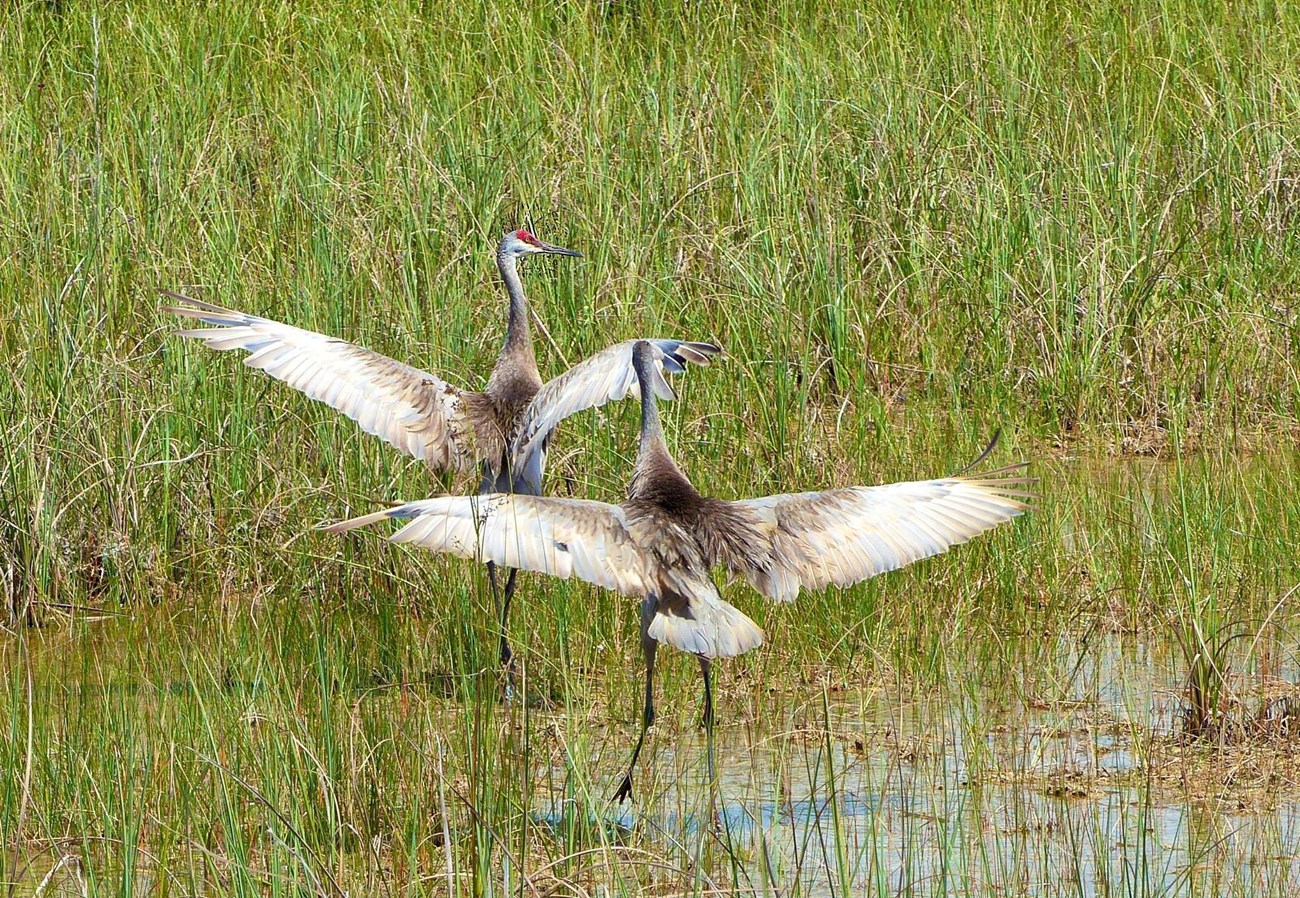Last updated: June 24, 2020
Article
Sandhill Crane

NPS/Everglades
General Description
Although the most common crane in North America, sandhill cranes (Antigone canadensis) are nothing short of extraordinary. They are named after the Sandhills near the Platte River in Nebraska, where many travel during spring migration. These elegant birds are known for their long legs, large wingspans, and graceful mating dance. Sandhill cranes are large birds, standing 1.0 to 1.2 m (3.2 to 3.9 ft) tall, with a wingspan of 1.8 to 2.0 m (5.9 to 6.5 ft). Males are slightly bigger than females, weighing an average of 3.75 kg (8.3 lbs) compared to the female’s average of 3.3 kg (7.2 lbs). Adults have an overall gray plumage with a white throat and a striking red crown of feathers on their forehead. Juveniles work their way up to those colors, wearing a lighter, rusty coat and lacking the white and red patches on their head until they are about a year old.
Habitat and Range
Sandhill cranes are migratory birds found across North America and northeastern Siberia. Every spring, they make their way north across North America for breeding, stopping in states like Nebraska, Idaho, Oregon, and Alaska to raise their young. Marshes, wet meadows, prairies, and other humid environments are great habitats for nest-building and raising their young. Cranes commonly build their nests out of reeds, grass, and other plants near the nest site, staying high enough out of the water and close enough to grassy open plains. Once the season turns colder, sandhill cranes return to warmer weather, traveling in flocks of up to 10,000 birds. The cranes fly south to states like Florida or New Mexico, some heading further down to northern Mexico, staying in wetlands and shallow lakes for the winter.
Behavior
Active during the daytime, sandhill cranes spend most of their time resting, foraging for food, or socializing with other birds, and for three months of each spring, raising their young. Sandhill cranes are famous for their loud trumpeting calls, made possible by elongated tracheas in their throats, which allow them to emit deeper frequencies. They can also control their trachea and make it shorter or longer, adjusting the pitch of their calls depending on their situation; loud, rattling calls can signal that a predator is near and soft purring-like clicks can mean a crane is about to take off in flight.
Diet
Plants comprise most of a sandhill crane’s diet, though it occasionally eats small mammals or amphibians. Its long beak allows it to probe the wetlands for seeds, berries, grains, and insects. Depending on its location, it will also eat cultivated food like corn and wheat.
Reproduction
Sandhill cranes typically find their mate during spring migration. Some find their mate as early as two years of age, and nearly all are paired by age eight. To attract a female’s attention, males perform a courtship dance. They will stretch out their wings, leap, and bow. Once the female is satisfied with a performance, the two mate and generally maintain a life-long bond with their partner.
The female lays between one to three eggs a year, with one hatchling typically surviving. Sandhill crane eggs are olive-colored with brown or gray speckles and vary depending on the female. In Oregon, eggs are laid from mid-April to mid-May and both parents take turns incubating the eggs for 29–32 days.
Chicks are born precocial, meaning they are already covered in down when they hatch and can leave the nest within a day of hatching. Once they are between two and two and a half months old, chicks take their first flight. Despite this, it can be between 10 and 12 months before the chicks are fully grown, and so they stay with the parents until a couple months before the following spring. After fully developing, they join a juvenile flock, eventually finding their mate and pairing with them in the new flock.
Conservation Efforts
While once headed towards the verge of endangerment due to hunting and habitat loss, sandhill crane populations have held steady or increased over the last few decades. However, human activity such as hunting and habitat disturbance still impact some populations. All populations are vulnerable to habitat loss from farming, human development, oil fields, and climate change. A National Audubon Society study estimates that an increase of 3ºC could result in sandhill cranes losing over a third of their North American range. Their future all depends on the conservation of the wetlands; without their breeding grounds, the sandhill crane cannot survive.
Fun Facts
- Some migrating sandhill cranes accidentally end up in Europe, which is called vagrancy.
- Wild sandhill cranes can live for 35 years.
- Sandhill cranes snore occasionally.
Where to See
Uncommon in Klamath Network parks, sandhill cranes have been spotted at Crater Lake NP, Lava Beds NM and Lassen Volcanic NP.
Learn More
https://www.nationalgeographic.com/animals/birds/s/sandhill-crane/
https://www.allaboutbirds.org/guide/Sandhill_Crane/overview
Download a pdf of this article
Prepared by Moriah Doepken, SOU science communication intern
NPS Klamath Inventory & Monitoring Network
Southern Oregon University
1250 Siskiyou Blvd
Ashland, OR 97520
Featured Creature Edition: June 2020
